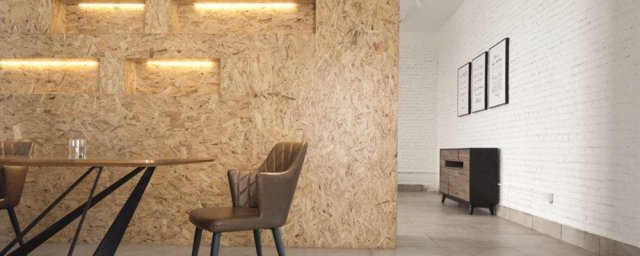OSB, also known as Ousong board, originated in the 1970s and developed from structural particleboard – waffle board. It has developed rapidly in North America and Europe since the mid-1980s, and has begun to replace plywood and fiberboard in a large number. As a new type of structural environmental protection board, it is mainly made of pine wood as raw material, processed into a certain thickness of planing pieces through special equipment, and processed through drying, screening, sizing, directional paving and other processes. The surface flakes of European pine board are arranged longitudinally, while the core flakes are arranged transversely. This crisscross arrangement reorganizes the wood texture structure and completely eliminates the impact of wood internal stress on processing.

What is the material of Ousong board?
- Material composition
European pine board is made of small-diameter wood, thinning wood and wood core. It is processed into 40-100 mm long, 5-20 mm wide and 0.3-0.7 mm thick flakes by special equipment. A kind of directional structural plate is made by deoiling, drying, sizing, directional paving, hot pressing and other processes.
The surface flakes of European pine board are arranged longitudinally, while the core flakes are arranged transversely. This crisscross arrangement reorganizes the wood texture structure and completely eliminates the impact of wood internal stress on processing. Make it better in processing and moisture resistance.
- Performance
Compared with plywood, MDF, etc. The expansion coefficient of Ousong plate is small, the stability is better, and the material is more uniform, because it is arranged in a certain direction when polishing. As a result, the longitudinal bending strength is greater than the transverse strength, and can be sanded, planed, drilled and nailed as the original wood.
- Main purpose
The formaldehyde content of Ousong board is extremely low, so more and more people use it, and it has gained a place in the artificial board, which is likely to become the first artificial board in the future. Its main uses include: floor, roof, wall, etc. It is also often used in the production of sound-absorbing boards and ceilings.
Advantages and disadvantages of Ousong board
- Advantage:
Ousong board is the source of Europe, with outstanding environmental protection performance. Its product environmental protection standards are basically high, and its safety is guaranteed when used. It is dry and degreased under high temperature and high pressure. It also has strong strength and hardness, good stability, and is not easy to deform and crack.
The advantages of Ousong board in waterproof, moisture-proof, fireproof and high-temperature resistance are several times that of ordinary large-core board. There are many colors and styles to fully meet the personalized needs of consumers. Different from other plates, the adhesive is used as environment-friendly adhesive. The surface of Ousong plate basically does not use melamine adhesive. The formaldehyde content is lower than the standard, and the environmental performance is good.
Due to the construction reason, the strength of the Ousong board is very high and the fire resistance is outstanding. With good corrosion resistance, it can be used for some wooden structure houses and interior decoration to replace blockboard.
- Disadvantages:
The high density and high hardness of Ousong board are not only its advantages, but also its disadvantages. It is not easy to drive nails into the board, which causes some difficulties to the processing of the board. In the process of construction, the surface of Ousong board will sometimes leave pits, and the flatness is not good enough, affecting the aesthetics.